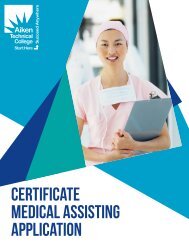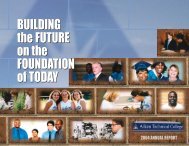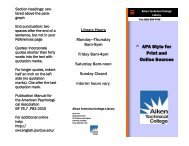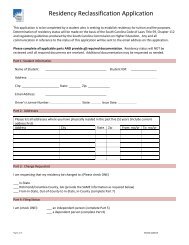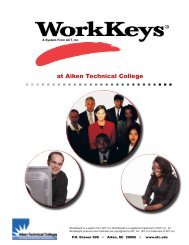2009 Accountability Report - Aiken Technical College
2009 Accountability Report - Aiken Technical College
2009 Accountability Report - Aiken Technical College
You also want an ePaper? Increase the reach of your titles
YUMPU automatically turns print PDFs into web optimized ePapers that Google loves.
4<br />
I.4. Opportunities and Barriers<br />
<strong>Aiken</strong> <strong>Technical</strong> <strong>College</strong> has made many improvements and revisions in its physical facilities, operations, and<br />
programming in recent years to create new opportunities and ameliorate barriers. In some cases, issues present<br />
both opportunities and barriers, as noted below in the bulleted list:<br />
Opportunities:<br />
• New and renovated instructional buildings resulting in technically current labs in several program areas and<br />
aesthetically pleasing surroundings.<br />
• Closing the achievement gap among low income and minority students through participation in the<br />
Achieving the Dream Initiative.<br />
• New technologies implemented to enhance student services and academic programming.<br />
• New academic programs that provide local educational opportunities in high demand, high wage career<br />
fields to include Radiation Protection Technology, Pharmacy Technician, and Paramedic Technician<br />
programs.<br />
• Organizational, work process and data management redesign leading to improved communications and<br />
effectiveness across all college divisions.<br />
• Workforce development programs and facilities unique in the region that are a major benefit to economic<br />
development efforts of the region.<br />
• Emergence of new technology and labor sectors in the local economy that can be addressed by new <strong>College</strong><br />
technical programming and partnerships with industry (credit and non-credit).<br />
Barriers:<br />
• Sharp decline in state support as a percent of total budget with significant increased reliance on student<br />
tuition and fees as a revenue source.<br />
• No state bond funds to replace aging and dysfunctional buildings on campus, resulting in higher maintenance<br />
and technology replacement costs.<br />
• Balancing allied health/nursing job demand with high program delivery costs in combination with declining<br />
state funding support for allied health.<br />
• Insufficient funding to begin new programming in response to community employment needs.<br />
• Changing local economic profile that has resulted in a stagnant manufacturing base and growth in the nuclear<br />
field, creating a large demand that cannot be immediately met.<br />
• Significant number of academically under-prepared students entering the <strong>College</strong>, resulting in the need for<br />
large numbers of remedial courses and decreased student retention due to low academic performance.<br />
• Increased student enrollment with insufficient state support for additional faculty and classroom space to<br />
meet the demand, therefore reducing student access to educational services.<br />
I.5. Use of <strong>Accountability</strong> <strong>Report</strong> to Improve Performance<br />
ATC uses the accountability process to seek continuous improvement in programs, services and operations.<br />
This serves as the foundation for the <strong>College</strong>’s Institutional Effectiveness (IE) process, which in turn requires a<br />
<strong>College</strong>-wide comprehensive planning and assessment process that identifies needed change; selects a direction



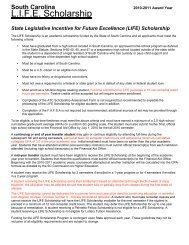
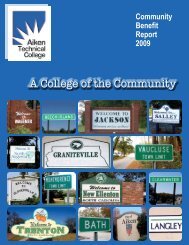
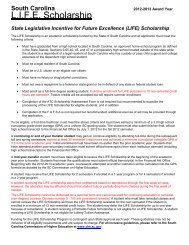
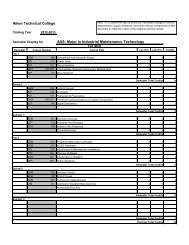

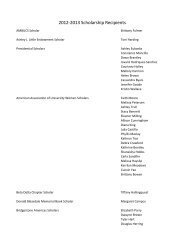
![MLA PowerPoint presentation [PDF] - Aiken Technical College](https://img.yumpu.com/36398339/1/190x143/mla-powerpoint-presentation-pdf-aiken-technical-college.jpg?quality=85)
